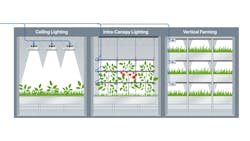Vertical farming and indoor horticulture make an increasingly important contribution to the global food chain. However, the energy needed to support plant growth is significant, not least in terms of the power requirements for lighting. In recent years, this has led to the rapid growth of LED-based lighting systems, which offer inherent efficiencies over conventional incandescent or fluorescent grow lights. However, many growers are not reaping the full benefits of LED efficiency due to the energy losses incurred in the schemes that provide power to the LEDs.
In this article, we look at how a combination of a centralized — rather than a distributed — approach to LED power and the latest innovations in power supply technology can reduce the cost of bulk horticultural LED lighting schemes, as well as simplify their implementation and maintenance. This approach can help ensure that growers receive the maximum return from their LED lighting investment.
Driven by LED lighting, indoor horticulture rises in prominence
Indoor horticulture, or controlled environment agriculture (CEA), enables increased yields and more predictable growing conditions independent of the weather. As environmental issues come to the fore, food producers are looking to reduce energy consumption through improved efficiency. Consumer awareness of the benefits of fresh, locally produced food have also increased rapidly. Through effective use of CEA, food that were previously imported from far away can now be grown closer to the point of consumption, reducing the cost of transport and its associated environmental consequences.
For years, incandescent bulbs or fluorescent tubes were the mainstay of indoor horticulture. This is changing with the increasing prevalence of LEDs , which offer longer lifetimes, lower energy consumption, and lower maintenance costs than conventional sources. The efficacy of LED lights is also superior, which also means fixtures operate at lower temperatures than high-pressure sodium (HPS) lamps. As a result, they can be placed closer to plants and increase farming density. Less heat also means less water consumption — and lower costs.
To date, traditional greenhouses have been the primary adopters of horticultural LED lighting, which is used to supplement natural light. However, in larger greenhouses — “growing warehouses” — LED lighting can improve control of the nutrient balance and growth cycle of a wide range of crops.
Meeting the standards
In emerging industries such as horticultural lighting, standards are critical to ensure that products available on the market are suited for the task. The DesignLights Consortium (DLC) is taking a lead in defining the technical requirements for horticultural lighting to ensure that solutions are capable of increasing yields while reducing energy consumption.
Its approach is twofold: It has published technical requirements and the first qualified product list (QPL) for energy-efficient horticultural lighting. The technical requirements cover parameters such as wavelengths and intensities, as well as parameters for the LED driver and power supply. The latter includes power factor, overall lifetime of the LED driver and power supply, warranty, and lifetime of any cooling fan, if fitted. The original DLC technical requirements were aimed specifically at integrated luminaires while its latest version, 2.1, also encompasses horticultural lighting based on remote power, an area in which power supply manufacturers played a key part.
The QPL helps assure growers that the lighting solution they select will meet the stated manufacturer’s performance claims. The standards undergo a major revision every 24 months, with interim reviews annually.
LED Lighting in horticulture
Greenhouses are typically illuminated from the ceiling. Generally, this is a good solution, but light distribution is often not uniform, meaning some plants receive more light than others. In vertical farming, the light is much closer to the plants, which can lead to heat issues and some plants shading others as they grow. Intracanopy lighting places the lights to the side or in between plants — a strategy previously impractical with the heat of conventional sources but now feasible with lower-heat LED sources, although light uniformity can remain a challenge.
Even though LEDs are far more efficient than legacy solutions, the sheer scale of farming operations means that electricity consumption remains a significant cost. Each installation is different, often because of different crops, but as a rule of thumb, around 100W of LED light is required per square meter for up to 18 hours every day.
The way that energy is used can also affect costs. If the current and voltage are not in phase, then an additional load is created that does no useful work but incurs charges from the energy supplier. Engineers know this as power factor (PF), which, along with waveform distortion or total harmonic distortion (THD), should be minimized to control costs.
Many LED installations will consist of luminaires that are powered by mains electricity with the voltage converted locally to DC. In addition to the amount of mains wiring needed, the challenge is that this configuration can lead to a poor PF and high THD. As these schemes are often single-phase, they can also create imbalance on the three-phase supply grid.
Any power conversion generates an amount of heat. By reconfiguring how energy is delivered to the LEDs, operators can achieve energy savings in excess of 10% over conventional setups, which locate power conversion in the growing area and deploy fans or air conditioning to regulate the grow area temperature, thus incurring additional capital and operating costs.
In a centralized approach, the power conversion from AC to DC is located outside the growing area. Excess heat can be vented to the outside world in the summer or channelled into the growing area in the winter. Furthermore, distributing DC to the LED fixtures delivers a grid- and budget-friendly solution with high PF and low THD. When high voltage is used, wires can be thinner, reducing costs and weight on the structure. And when currents are lower, wiring losses are significantly reduced.
A configurable front-end power solution can deliver up to 24 kW of DC power in a three-unit rack. In this type of modular supply, the outputs are configured using plug-in modules that are flexible and can be rapidly reconfigured should the needs of the application change. Generally, control of the power solution can be digital or analog, and configuration and monitoring is done through a supplied software graphical user interface (GUI). Some vendors offer additional scheduling and control software specifically tailored for horticultural applications.
Another valid approach is to use a rack-mount power solution and mounting shelf to provide bulk power for the LED lighting. Such systems have been designed specifically for horticulture applications in compliance with the DLC technical requirements for horticultural lighting (Version 2.1) as they apply to remote power sources.
Ideally, the solution chosen would allow all standard AC inputs (208 VAC to 600 VAC) from single or three-phase sources and provide flicker-free current at an output voltage between 100 VDC and 300 VDC. For large systems, generally greater than 25 kW, stacking multiple unit shelves in a relatively small cabinet — say, 3 ft tall — would provide 120 kW, a typical power requirement for a grow area.
One benefit of using 19-in. rack-mount power is the simplicity of maintenance. Replacing a ceiling luminaire in a conventional setup requires technicians to enter the growing area with ladders and tools, working around and over planting areas. However, in the unlikely event of an issue with a rack-mount power solution, workers can pull the unit out, often without needing tools, and push in a new one. In many cases, they wouldn’t need to cut off power to the entire facility to perform this swap. Indeed, it is very similar to opening and closing a drawer.
Summary
LED technology has opened a world of opportunities in horticultural lighting. In times of rising energy costs, the efficiency of LED technology dramatically reduces operating costs and allows greater flexibility with lamp placement.
A centralized and remote power solution can further enhance operating efficiency and eliminate the need for additional cooling within the growing area. These benefits can add up to reduce costs and create a simple and more reliable CEA system.
Get to know our expert
JOE VOYLES is vice president of industrial power conversion at Advanced Energy, which is headquartered in Denver, CO. Voyles has more than 25 years of experience in the electrical and electronic manufacturing industry.
Advanced Energy Industries, Inc. is a producer of power supplies and power generation technologies for the semiconductor and industrial sectors.
For up-to-the-minute LED and SSL updates, why not follow us on Twitter? You’ll find curated content and commentary, as well as information on industry events, webcasts, and surveys on our LinkedIn Company Page and our Facebook page.







